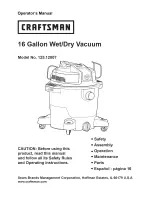
US-14
EBZ7500/RH
■
SPARK PLUG
• The spark plug may gather carbon
deposits on its firing end with
reasonable use. Remove and inspect
the spark plug every 25 hours and
clean the electrodes as necessary with
a wire brush. The spark gap should be
adjusted to .025 in (0.6~0.7mm).
• Plug manufacturers recommend
replacing the plug twice a year to avoid
unexpected plug failure in a job.
REPLACEMENT PLUG IS A NGK
CMR7H.
• Note that using any spark plugs other
than those designated may result in the
engine failing to operate properly or in
the engine becoming overheated and
damaged.
• To install the spark plug, first turn the
plug until it is finger tight, then tighten it
a quarter turn more with a socket
wrench.
■
MUFFLER
• Inspect periodically, the muffler for
loose fasteners, any damage or
corrosion. If any sign of exhaust
leakage is found, do not use the blower
and have it repaired immediately.
• Note that failing to do so may result
in the engine catching on fire.
• Before starting operation, always make
sure to check if the muffler is properly
held by three bolts (F21 (2)).
(Fastening Torque : 8 to 12 N·m)
• Also make sure that the speark arrester
and the diffuser are properly attached
with four bolts (F21 (1)). (Fastening
Torque : 2 to 3 N·m)
• Even if one of seven bolts is loose, it
may result in engine catching on fire.
(1) Bolt
(2) Bolt
(4) Spark arrester
(5) Diffuser
IMPORTANT
WARNING
IMPORTANT
F21
9. Maintenance
F20
■
SPARK ARRESTER
• The muffler is equipped with a spark
arrester to prevent red hot carbon from
flying out of the exhaust outlet.
Periodically inspect and clean as
necessary with a wire brush. In the
State of California it is required by law
(Section 4442 of the California Pulic
Resources Code) to equip a spark
arrester when a gas powered tool is
used in any forest covered, bush
covered, or grass covered unimproved
land.
■
PROCEDURES TO BE PERFORMED
AFTER EVERY 100 HOURS OF USE
1. Remove the muffler, insert a
screwdriver into the vent, and wipe
away any carbon buildup. Wipe away
any carbon buildup on the muffler
exhaust vent and cylinder exhaust port
at the same time.
2. Tighten all screws, bolts, and fittings.
■
AIR INLET NET
• Blowing air is taken in from the air inlet
net. When air flow has dropped down
during operation, stop the engine and
inspect the air inlet net for blocking by
obstacles.
• Note that failure to remove any such
obstacles may result in the engine
becoming overheated and damaged.
(1) Net
Never use the blower without the net of
the blower. Before each use, check
that the net is attached in place and is
free from any damage.
■
IGNITION COIL AIR GAP
INSPECTION
• If the gap is out of standard or when
installing the coil or rotor, adjust the air
gap between the ignition coil and the
iron core of the rotor.
Air Gap:
0.30mm (0.3 ~ 0.4mm)
0.012" (0.012 ~ 0.016")
(1) Rotor
(2) Ignition coil
WARNING
IMPORTANT
F24
(1)
F23
F22
















































